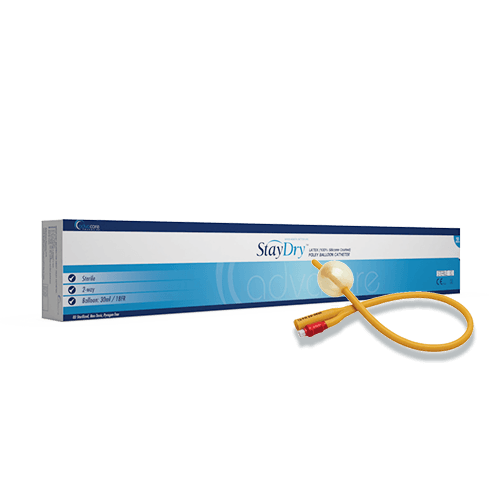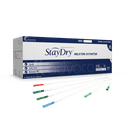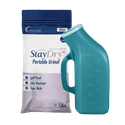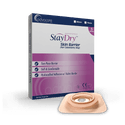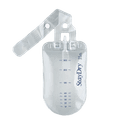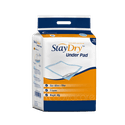- Home›
- Medical Devices›
- Incontinence & Urology Supplies›
- Urology Supplies›
- Foley Catheters
Foley Catheters
Material
Type
Catheter Tip
Length
Ballon Capacity
Color-coded Size
Packaging
What are Foley Catheters?
Foley Catheters, also called indwelling catheters, are flexible tubes inserted into the bladder through the urethra to allow urine to drain. Models vary based on tip, material, length, and size. Foley catheters are commonly used for patients with urinary retention, neurological disorders, or recovering from surgery.
Urine catheters should only be used under medical supervision and with proper training in insertion and care. Improper use or care can lead to complications such as infection, bladder damage, or blockage.
AdvaCare Pharma produces Foley Catheters in ISO and CE-certified facilities situated in China, India, and the USA, ensuring their safety and dependability. Our incontinence products are made using premium materials and are customized to meet the demands of healthcare providers and patients worldwide. We adhere to stringent quality control protocols to guarantee that our indwelling catheters are reliable.
Product Specifications
Material
Type
Catheter tip
Latex with Silicone Coated
Latex with Silicone Coated foley catheters are made of high-quality latex material with a silicone coating that provides an additional layer of protection for the patient's tissue. The latex material makes the catheter flexible and durable, while the silicone coating protects against potential allergic reactions to latex. These catheters are designed to be inserted into the bladder through the urethra and left in place to allow urine to drain. The silicone coating also helps to reduce friction during insertion and removal.

100% Silicone
100% Silicone foley catheters are made of pure medical grade silicone material, making it a suitable choice for long-term use. The transparent design and radiopaque tip and line along the catheter shaft allow for easy visualization during insertion and monitoring. As a latex-free option, it is suitable for patients with latex allergies. The larger drainage lumen compared to traditional latex foley catheters may help to improve flow rates, drainage, and removal of blood clots.
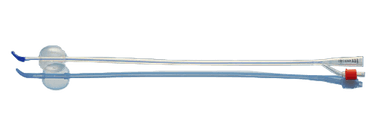
2-way Indwelling
2-way Indwelling is a type of catheter that has two lumens: one for draining urine and another for inflating a small balloon at the end of the catheter. This balloon is used to hold the catheter in place within the urethra after it has been inserted. The catheter is typically made of latex or silicone, and is a flexible and durable medical device.

3-way Indwelling
3-way Indwelling foley catheter has 3 lumens or channels, 2 of which are similar to a 2-way foley catheter, and the third lumen is designed for bladder irrigation. The third lumen is used to pass a sterile solution through the tube to remove blood and blood clots from the bladder. 3-way foley catheters are typically recommended for post-surgery use or in the case of patients with a known tendency for blood clot formation.

Straight
Straight Foley catheter tip features a smooth surface with a cylindrical and solid tip that has two opposing drainage eyes. This catheter design ensures a gentle introduction and allows for efficient urine drainage. Available in 2-way and 3-way models, it is suitable for use in a range of medical procedures.

Tiemann Foley
Tiemann Foley catheter is a 2-way catheter with a 45-degree angled tip designed to facilitate insertion through the male urethra. It is also known as the Coude tip, which helps to navigate obstructions caused by conditions like benign prostatic hyperplasia or urethral strictures. The catheter has a single smooth eye for optimal drainage and is designed for single-use. Made of radiopaque material, it can be easily visualized on x-rays to ensure proper positioning. The Tiemann foley catheter is an effective tool for managing urinary retention or incontinence in male patients with urethral obstructions.

Why are we a leading Foley Catheter manufacturer?
AdvaCare Pharma is a trusted manufacturer of Foley Catheters and other quality-assured urological medical devices. Our StayDry™ range of incontinence and urology products are designed with maximum efficacy and safety in mind while minimizing environmental impact. We manufacture foley catheters and other urology medical devices in our production facilities located in China, India, and/or the USA.
With more than two decades of experience in the healthcare industry, AdvaCare Pharma has established a robust distribution network that spans across 65 markets worldwide. Our primary focus is on building strong relationships with our partners and distributors, which enables us to provide customized and market-specific solutions that cater to their unique needs.
Uses
What's the recommended procedure for Foley Catheter insertion?
Foley Catheters demand skilled handling for insertion, emphasizing sterility to mitigate infection or harm risks:
- The procedure initiates with thorough cleansing and disinfection at the urethral opening to deter bacteria from entering the bladder.
- In male patients, a Tiemann or coude-tipped catheter may be opted for to circumnavigate obstacles like an enlarged prostate.
- Post insertion, the catheter's balloon is inflated with sterile fluid, securing it within the bladder to prevent accidental removal.
- Continuous, vigilant hygiene around the catheter and its drainage system is paramount to ward off urinary tract infections.
- Regular catheter and urine collection bag inspections are advised to monitor output and prevent complications such as reflux or obstruction.
How are Foley Catheters cleaned and properly discarded?
Foley Catheter maintenance and disposal warrant strict compliance to healthcare protocols to avert contamination and infection spread. Regular catheter and urine bag drainage are imperative for monitoring urinary output and maintaining a sterile environment.
Cleansing involves flushing the catheter and tubing with sterile saline or a specified cleaning agent for unimpeded flow and cleanliness. Disposal should follow healthcare facility protocols, typically involving placement in biohazard containers to safely manage infectious waste, safeguarding patient health and environmental integrity.
What complications might arise from Foley Catheter usage?
The utilization of Foley Catheters, while medically required for many, does bring with it the possibility of various complications. The spectrum of these issues can range from mild inconveniences to more severe medical concerns.
Urinary tract infections (UTIs) are among the most common complications, given the direct pathway of the catheter to the bladder, bacteria can enter. Symptoms of a UTI may include discomfort, fever, and changes in urine clarity or odor, necessitating immediate medical intervention to prevent escalation.
Discomfort, often stemming from the catheter's presence in the urethra, can affect patient well-being and quality of life. This sensation may be mitigated through the use of lubricated catheters or those made from materials designed to reduce friction.
More severe complications include urethral damage, which can occur from incorrect catheter insertion or prolonged use, leading to strictures or tears in the urethra. Allergic reactions, though less common, may arise from sensitivity to catheter materials, such as latex.
Catheter blockages represent another challenge, potentially leading to urine retention and bladder distention. Regular monitoring and flushing of the catheter can help prevent this issue. Improper positioning or inflation of the catheter's balloon can cause discomfort or injury to the bladder walls.
To mitigate these risks, healthcare providers are advised to maintain rigorous standards of hygiene and catheter care, including sterile insertion techniques, regular catheter and site cleaning, and prompt replacement of the catheter system. Continuous education for both medical personnel and patients on the correct handling and care of catheters is also paramount.
How do 2-way and 3-way Foley Catheters differ?
2-way Foley Catheters consist of dual lumens for urine drainage and balloon inflation, typically serving for straightforward urinary management.
In contrast, 3-way Foley Catheters incorporate an extra lumen for bladder irrigation, facilitating blood clot and debris removal following surgery or in patients prone to clot formation.
The choice between catheter types hinges on the patient's specific medical requirements and healthcare professional recommendations.
Is Foley Catheter use appropriate for children?
Yes, Foley Catheters are adaptable for pediatric use, tailored in size and design to fit young patients. Their application should be carefully monitored by healthcare professionals adept in pediatric care, assuring catheterization is conducted safely and comfortably.
Appropriate catheter selection, insertion, and maintenance minimize risks and provide therapeutic efficacy in pediatric patients.
FAQs
How does a Foley Catheter work?
A foley catheter consists of two main parts: a hollow tube with drainage eyes and an inflatable balloon. The tube is inserted through the urethra into the bladder, while the balloon is inflated with sterile water once inside the bladder. The inflated balloon keeps the catheter in place, while the drainage eyes allow urine to flow into a collection bag.
How long can a Foley Catheter stay in place?
The duration a Foley catheter can stay in place varies depending on the patient's condition and the healthcare professional's recommendation. In some cases, it may be necessary to leave the catheter in place for an extended period, while in others, it may only be needed temporarily. Regular monitoring, catheter care, and scheduled catheter changes are essential to prevent complications such as infection or blockage.
How should Foley Catheters be cared for and maintained?
Keep the catheter and drainage system clean, following the healthcare professional's instructions. Maintaining a sterile and closed drainage system, regular cleaning of the catheter and surrounding area, and maintaining good hygiene practices when handling the catheter and collection bag are important aspects of catheter care.
Can Foley Catheters be used for both male and female patients?
Yes, Foley catheters are suitable for use in both male and female patients. They come in various sizes, lengths, and configurations to accommodate anatomical differences and individual patient needs. Healthcare providers select the appropriate catheter size based on factors such as patient age, gender, and medical condition.
What are the alternatives to Foley Catheters for urinary drainage?
Alternatives to foley catheters for urinary drainage include intermittent catheterization, suprapubic catheterization, external urinary collection devices (condom catheters), and urinary diversion surgeries. Healthcare providers assess individual patient needs and preferences to determine the most appropriate method of urinary drainage.
Is it possible for me to distribute your Foley Catheters in my region?
Yes, we routinely grant distribution rights to partners who are keen on distributing our Class I and Class II medical devices within their regions. For inquiries regarding distribution opportunities in your territory, please contact our International Sales Department.
References
Urinary catheters: history, current status, adverse events and research agenda
This article provides a brief history of the development of the urinary catheter and discusses the adverse events caused by the Foley catheter, which is indispensable in modern clinical practice. The Foley catheter can cause bacterial colonization, recurrent and chronic infections, bladder stones and septicaemia, damage to the kidneys, the bladder and the urethra, and contribute to the development of antibiotic resistance. The article emphasizes the need for the development of an alternative indwelling catheter system that is easy and safe to insert, retained reliably in the bladder, and withdrawn easily and safely when necessary.
Do Foley Catheters Adequately Drain the Bladder? Evidence from CT Imaging Studies
This study aimed to assess the adequacy of Foley catheter for complete drainage. The study indicated that the vast majority of patients with Foley catheters had adequately drained bladders with volumes of <50 mL. The study also emphasized the importance of catheter placement technique and urine output monitoring.

You might be interested in...
Why AdvaCare Pharma?
As an industry leader, we are aware of our responsibility to provide affordable and sustainable solutions to improve healthcare worldwide.
